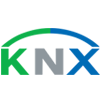KNX Technology Overview
The Preferred International Standard for Building Automation
KNX is a communication protocol developed for — and widely used in —home and building automation. It is a standardized (EN 50090, ISO/IEC 14543), OSI-based network communications protocol that is administered by the KNX Association.
The standard is based on the communication stack of the European Installation Bus (EIB) but enlarged with the physical layers, configuration modes, and application experience of BatiBUS and EHS.
KNX defines several physical communication media:
- Twisted pair wiring (inherited from the BatiBUS and EIB Instabus standards)
- Powerline networking (inherited from EIB and EHS– similar to that used by X10)
- Radio Frequency (KNX-RF)
- Infrared
- Ethernet (also known as EIBnet/IP or KNXnet/IP)
The Radio Frequency Versions: KNX RF, RF Ready, and RF Multi
Radio Frequency KNX is the wireless version of the KNX physical layers. KNX RF can share the application layers with the other media versions of KNX, so it’s completely compatible on the application level, making KNX RF an ideal complement to wired or IP KNX.
Currently there are three variants of the KNX RF specification:
- The original KNX RF.
- KNX RF Ready, which added some features to be forward compatible with KNX RF Multi.
- And KNX RF Multi, designed to meet some of the shortcomings of the previous protocol while improving reliability by using more than one RF channel.
The original KNX RF was specified in Supplement 22 of the KNX Specification 1.1 [KNX]. KNX RF operates at 868.3 MHz using FSK modulation at a data rate of 16.4 kbit/s. The PHY and MAC layers of KNX RF were defined jointly by the EN 13757-4:2005 (Wireless M-Bus) standard for wireless meter reading, allowing some degree of interoperability between the two protocols.
KNX RF allows unidirectional (transmit-only) devices, in addition to conventional bidirectional ones. By eliminating the receiver function, the device designer can extend the battery lifetime of building automation sensors.
KNX RF Device Addressing Scheme
Due to the nature of wireless communication and the support of transmit-only devices, KNX RF uses its own addressing scheme which is different from (although similar to) the standard KNX addressing scheme. Since RF is an open medium, the address spaces of neighboring installations would interfere with each other. Therefore it has to be guaranteed that each KNX RF installation has its own address space. Extended addresses are used for this purpose. An extended address is defined as the combination of the traditional KNX address and the serial number (SN) of the device.
KNX RF Multi: Expanding to Multiple Frequencies
Two new versions were added to the standard KNX RF Ready as an intermediate forward compatible version, and then finally the KNX RF Multi was released. The main difference between KNX RF Ready and KNX RF Multi is in the use of frequencies. KNX RF Ready can only communicate at a center frequency of 868.3 MHz, but it can co-operate with KNX RF Multi.
Switching Between Fast & Slow Channels in KNX RF Multi
With KNX RF Multi it is possible to switch between three “fast” and two “slow” channels. If there is interference, the KNX RF Mulit device will automatically change channel.
The fast channels are intended for human activities, such as switching on or dimming lights, that require fast response times. The slow channels are for applications which do not need low latency, such as heating, ventilation and air-conditioning (HVAC).
On the fast channels the data rate is 16.384 kbit/s and on the slow channels it’s 8.192 kbit/s. KNX RF Multi offers the further benefit of immediate acknowledgement of the telegrams sent. These are called »Fast Immediate Acknowledge« (IACK).
Wireless Range of KNX RF
The typical line-of-sight range of KNX RF at 868 MHz is 150 meters. Within a building the range very much depends on the actual environment, building materials, etc. Under good circumstances ranges of 30 meters are possible within a building. That said, device designers should conservatively plan on a range of 20 meters so that a “range reserve” is available. KNX RF also support multi-hop repeaters to extend the range.
Benefits of Using KNX RF
 Intermediate Standard designed for Building Automation |
Fully compatible on an application level with other KNX media: Twisted pair, PLC and Ethernet |
 Supports long-life battery operation |
|---|---|---|
Reliable radio protocol using listen-before-talk, multiple channels, repeaters, acknowledgement and re-transmissions
|
 Hardware independent protocol
|
A single design and commissioning tool (ETS) that is manufacturer-independent
|
A complete set of supported configuration modes (system and easy mode)
|
Any product labeled with the KNX trademark is conforming to the standard assured by KNX-accredited, third-party test lab
|
Operational Features of KNX RF
- 868 MHz, license-free band implementation; 433 MHz outside Europe
- Achievable line-of-sight range of 150 meters, with 20 meters as a practical range for indoor networks
- Fast link acknowledgement
- Binding up to 64 receivers (slaves)
- Listen-Before-Talk (LBT) and Automatic Retransmission
- Multi-hop repeaters
- Supports unidirectional and bidirectional devices
- Ultra low power modes for extended battery lifetime
- International standard EN 50090 (ISO/IEC 14543-3)
Examples of Building Automation Using KNX RF Networking
Bus devices can either be sensors or actuators needed for control of building management equipment such as:
- Lighting
- Blinds / shutters
- Security systems
- Energy management
- Heating, ventilation and air-conditioning systems (HVAC)
- Signaling and monitoring systems
- Interfaces to service and building control systems
- Remote control
- Metering
- Audio / video control
- White goods (refrigerators, washers, dryers, etc.)
Radiocrafts KNX RF Modules for Home and Building Automation
The Radiocrafts RC11 Series is a cost effective sub-GHz platform that supports KNX RF Multi on 433 and 868 MHz. The RF modules have a UART interface for serial communication and configuration. For complete descriptions and documentation, please visit:







